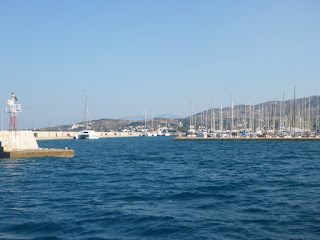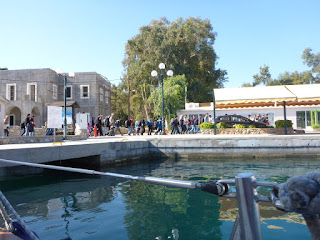Jeudi 8 octobre 2015
Nous
allons dire au revoir à Richard et Wendy, eux aussi partent mais pour aller
mettre leur bateau à terre au nord de l’ile. Je fais la photo bye, bye
avec le drapeau en haut, nouveau style. Très bonne et tranquille traversée de
Leros à Kos. Nous voyons nettement la Turquie, à gauche, très construite
d’immeubles blancs le long de la côte et Kos à droite. Nous arrivons à la
marina de Kos à 16 h 30, un « marinero » vient au devant de nous en
dinghy et un autre attend sur le ponton. Nous avons une place pour une nuit,
demain ils attendent les charters qui reviennent à leur base et ce n’est pas
sûr qu’on ait une place. On verra. Jens va au bureau s’inscrire et chercher la
pièce de rechange, le relais, pour l’hélice transversale. Il faut que je vous
raconte comment la pièce est arrivée ici, à Kos. Le grand chandler d’Ermoupolis
ne l’avait pas alors Jens a téléphoné à notre ami Knut qui était toujours à
Naousa, à Paros. Knut est allé chez le chandler de Naousa et lui a demandé s’il
avait cette pièce. Non, mais il pouvait la faire venir d’Athènes. Il l’a faite
venir et Jens lui a demandé de l’envoyer ici. Et voilà, merci à Knut pour son
aide. Moi, je ne voulais pas venir à Kos, c’est l’ile qui est la plus proche de
la Turquie et qui reçoit le plus d’émigrés. Mais, c’est aussi un port où on
peut régler tous les papiers nécessaires pour sortir légalement de Grèce. Vers
17 h 30, nous allons nous promener en ville. C’est déprimant, d’un côté les
hôtels, les restaurants et de l’autre les tentes des émigrés. Ici, ce sont des
hommes, jeunes et bruns, sans papiers et qui risquent d’être renvoyés chez eux.
A Lakki, c’était des familles de Syriens qui, venant d’un pays en guerre,
resteront en Europe. On voyait qu’ils étaient contents, optimistes. Ici, cela
ressemble à la jungle de Calais avec le soleil en plus. Nous rentrons au
bateau, je fais le blog et Jens repart, en vélo au bureau de l’émigration pour enregistrer notre sortie de Grèce. Mais
demain, il faut qu’il aille à la police du port et à la douane. Puis nous
allons diner, et comme c’est souvent le cas ici, le propriétaire refuse le
paiement par carte, soi-disant à cause du « capital control », hum,
hum, nous suspectons que c’est pour ne pas payer d’impots.
Thursday, October 8, 2015
We go to say goodbye to Richard and Wendy, they also
leave today to put to their boat ashore north of the island. I make the picture
bye, bye with the flag up, new style. Very good and quiet crossing from Leros
to Kos. We see clearly Turkey, on the left, with many white buildings along the
coast and Kos on the right. We arrive at Kos marina at 4:30 pm, a
"marinero" on a dinghy comes to meet us and another one is waiting for
us on the pontoon. We have a berth for one night, tomorrow they expect the charters returning to their base and it' s not
sure that we'll have a place. We will see. Jens goes to the office to register and
to pick up the replacement part, the relay for the bow thruster. I must tell
you how the piece came here in Kos. The large chandler in Ermoupolis didn’t have
it. Jens phoned our friend Knut who was still in Naousa, in Paros. Knut went to
the chandler in Naousa and asked him if he had that piece. No, but he could order
it from Athens. He did and Jens asked him to send it here. And here it is, thank
you for your help, Knut. I didn’t want to come to Kos, the island that is
closest to Turkey and who receives the most immigrants. But it is also a port
where we can do all the necessary papers to leave legally Greece. At 5:30 pm,
we take a walk around town. It's depressing, on one side hotels, restaurants
and on the other side the emigrants tents. Here, they are men, young and brown,
undocumented and at risk of being sent home. At Lakki, it was Syrian families
who, coming from a country at war, will remain in Europe. You could see they
were happy, optimistic. Here, it looks like the Calais jungle only with more
sun. We return to the boat, I do the blog and Jens ride back to the emigration office to register our departure from Greece.
But tomorrow he must go to the port police and to customs. Then we dine, and as
it is often the case here, the owner refuses card payments, supposedly because
of "capital control", hum, hum, we suspect that it is to evade taxes.
Bye, bye Lakki
Richard et Wendy sortent en même temps que nous
Richard and Wendy are leaving at the same time than us
La Turquie
Turkey
Un bateau turc
A turquish boat
Kos marina
Le paquet est arrivé
The package is here
Le fameux relais, ce n'est pas grand mais c'est important
The famous relay, it's not big but it's important
On ne voit pas Maja, mais on voit son drapeau
We can't see Maja, but we see her flag
Il y a une piste cyclable à Kos
Kos has a bicycle path
C'est comme à Calais
It's like in Calais
Ils font la queue pour avoir du pain et une banane
They are queuing to get a piece of bread and a banana
Kos























































